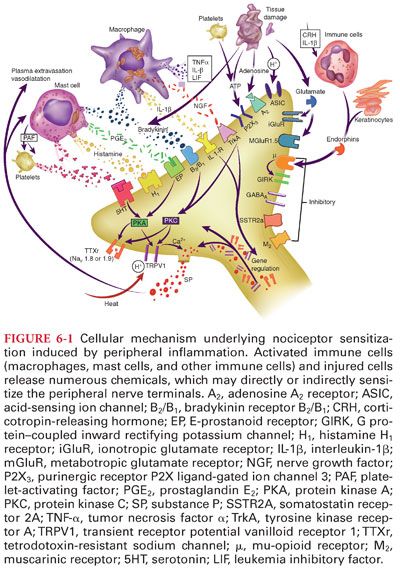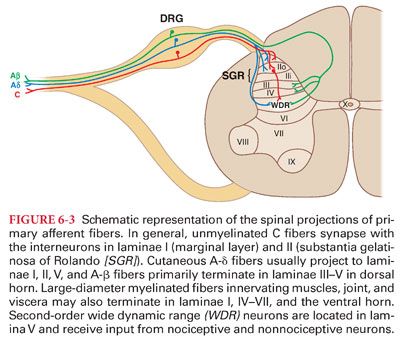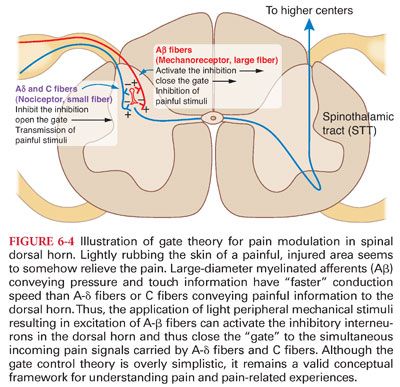III. Peripheral Nerve Physiology of Pain
A. Nociceptors (pain receptors) are a specialized class of primary afferents that respond to intense, noxious stimuli in skin, muscles, joints, viscera, and vasculature.
1. Nociceptors are inactive until they are stimulated by sufficient energy to reach the stimulus (resting) threshold.
2. Specific types of nociceptors react to different types of stimuli (Table 6-2).

B. Sensitization of nociceptors refers to the increased responsiveness of peripheral neurons responsible for pain transmission to heat, cold, mechanical, or chemical stimulation (attributable to the release of inflammatory mediators and adaptation of signaling pathways).
1. Chronic pain occurs if the conditions associated with inflammation do not resolve, resulting in sensitization of peripheral and central pain signaling pathway and increased pain sensations to normally painful stimuli (hyperalgesia) and the perception of pain sensations in response to normally nonpainful stimuli (allodynia).
2. Numerous endogenous chemicals, neurotransmitters, and peptides (such as substance P) can directly activate nociceptors, whereas others (serotonin, histamine) may activate the inflammatory cells which, in turn, release cytokines (Fig. 6-1).

C. Primary Hyperalgesia and Secondary Hyperalgesia
1. Tissue injury and inflammation may activate a cascade of events leading to enhanced pain in response to a given noxious stimulus (hyperalgesia).
2. Hyperalgesia at the original site of injury is termed primary hyperalgesia, and hyperalgesia in the uninjured skin surrounding the injury is termed secondary hyperalgesia.
IV. Central Nervous System Physiology. Pain transmission from peripheral nociceptors to the spinal cord and higher structures of the CNS is a dynamic process involving several pathways, numerous receptors, neurotransmitters, and secondary messengers (Fig. 6-2).

A. Dorsal Horn: The Relay Center for Nociception
1. Afferent fibers from peripheral nociceptors enter the spinal cord in the dorsal root, ascend or descend several segments in Lissauer’s tract, and synapse with the dorsal horn neurons for the primary integration of peripheral nociceptive information.
2. The central terminals of primary afferents occupy highly ordered spatial locations in the dorsal horn. The dorsal horn consists of six laminae (Fig. 6-3).

B. Gate theory proposes that painful information is projected to the supraspinal brain regions if the gate is open, whereas painful stimulus is not felt if the gate is closed by the simultaneous inhibitory impulses (Fig. 6-4).

Stay updated, free articles. Join our Telegram channel

Full access? Get Clinical Tree


